Incommensurate-commensurate magnetic phase transition in double tungstate Li2Co(WO4)2
Xiyu Chen(陈西煜) Ning Ding(丁宁) Meifeng Liu(刘美风) Tao Zou(邹涛) V.Ovidiu GarleaJingwen Gong(龚婧雯) Fei Liu(刘飞) Yunlong Xie(谢云龙) Lun Yang(杨伦) Shuhan Zheng(郑书翰)Xiuzhang Wang(王秀章) Shuai Dong(董帅) T.Charlton and Jun-Ming Liu(刘俊明)
1Institute for Advanced Materials,Hubei Normal University,Huangshi 435002,China
2School of Physics,Southeast University,Nanjing 211189,China
3Collaborative Innovation Center of Light Manipulations and Applications,Shangdong Normal University,Jinan 250358,China
4Neutron Scattering Division,Oak Ridge National Laboratory,Oak Ridge,Tennessee 37831,USA
5Laboratory of Solid State Microstructures and Innovative Center of Advanced Microstructures,Nanjing University,Nanjing 210093,China
Keywords: Li2Co(WO4)2,incommensurate-commensurate magnetic transition
1. Introduction
Frustrated magnetic systems, especially those with lowdimensional characteristics,have drawn considerable attention due to their exotic magnetic ground states and novel quantum phenomena originating from strong quantum fluctuations.[1-5]In ideal low-dimensional antiferromagnets,three-dimensional long-range magnetic ordering does not form even at absolute zero temperature.[6]However, the three-dimensional long-range magnetic orders have been observed in most lowdimensional antiferromagnets at finite temperatures due to weak interchain or interlayer couplings under zero magnetic field (or an external critical magnetic field).[7-11]Besides, frustration also plays a crucial role in these magnetic systems. Frustrated magnetic interactions can enhance the spin fluctuations which suppress magnetic ordering temperatures.[12,13]Further, it potentially engenders noncollinear magnetic ground states and induces spontaneous ferroelectric polarization.[14,15]In recent years, cobalt-based frustrated magnets have been extensively explored due to their fascinating physics,such as field-induced order-disorder transition and quantum criticality in Ising-like screw chain SrCo2V2O8and BaCo2V2O8,[16-19]1/3 quantum magnetization plateau in Ba3CoSb2O9,[20]spin-driven multiferroicity in Ba3CoNb2O9,[15]quantum spin liquid states in Co-based triangular lattice Na2BaCo(PO4)2,[21]and potential fieldinduced Kitaev quantum spin liquid in BaCo2(AsO4)2.[22]The discovery of such strange magnetic behaviors and novel magnetic ground states has evoked the research interests in more Co-based magnets.[23-25]
In this work, another Co-based magnet will be studied.Li2Co(WO4)2was reported to possess two successive antiferromagnetic (AFM) transitions atTN1~9 K andTN2~7 K,and the magnetic susceptibility displays a broad maximum associated with short-range spin order around 11 K.[26]This system belongs to the double tungstates family Li2M(WO4)2(M= Co, Ni, Cu) transition metal oxides where magnetic ions form quasi-triangular lattices and, thus, the strong frustrated magnetism could be observed in this family.[26-29]Recently, nuclear magnetic resonance(NMR)and neutron powder diffraction (NPD) measurements were carried out on the sister compound Li2Ni(WO4)2. It has been confirmed that this compound enters the incommensurate spin-density-wave(SDW) type state below 18 K, followed by a commensurate AFM state with the propagation vectork=(1/2,0,1/2) below 12.5 K.[27]In contrast, the other known member of this series, Li2Cu(WO4)2, undergoes a single AFM transition below approximately 3.9 K to a collinear AFM state defined by the propagation vectork=(0,1/2,0).[29]Meanwhile,another family of double tungstatesAIBIII(WO4)2(A= alkali metal,B=trivalent cation or rare-earth element)has also been extensively studied.[30-34]Similar to Li2Co(WO4)2, LiFe(WO4)2also undergoes two sequential AFM phase transitions.[32]Interestingly, LiFe(WO4)2was confirmed as a type-II multiferroic material.[32]Recently, we reported a study on double molybdates LiFe(MoO4)2.[35]Similar to Li2M(WO4)2(M=Co,Ni,Cu),LiFe(MoO4)2belongs to the triclinic space groupP-1(No.2). NPD revealed that it orders with a commensurate propagation vectork=(0,1/2,0).[35]The magnetic structure of Li2Co(WO4)2remains unclear.
In this work,we will focus on the determination of magnetic structure of Li2Co(WO4)2by means of neutron powder diffraction and theoretical calculations. Li2Co(WO4)2undergoes two successive magnetic phase transitions atTN1~9.4 K andTN2~7.4 K. Neutron diffraction reveals that Li2Co(WO4)2enters an incommensurate magnetic state with varyingkbetweenTN1andTN2. The magnetic propagation vector locks-in to a commensurate valuek=(1/2,1/4,1/4)belowTN2. The AFM structure is refined at 1.7 K with Co2+magnetic moment 2.8(1)µB, which is further confirmed by our first-principles calculations.
2. Methods
Polycrystalline Li2Co(WO4)2samples were synthesized using the conventional solid-state reaction method.Highly purified Li2CO3,CoO,and WO3powder were mixed and ground in a stoichiometric ratio of 1:1:2 and fired at 550°C for 24 h in air. The resultant powder samples were reground and pressed into pellets and heated at 650°C for 24 h in air.The phase purity of Li2Co(WO4)2was checked using x-ray diffraction (XRD) with CuKαradiation at room temperature(SmartLab Se,Rigaku). The magnetic susceptibilityχ(T)under different applied magnetic fields (H) was measured using a physical property measurement system (PPMS, Quantum Design)in zero-field cooling(ZFC)and field cooling(FC)modes. The specific heat(Cp)was measured using the heat relaxation method on PPMS. NPD measurements were carried out at the HB2A diffractometer,ORNL.
The first-principles calculations were performed on the basis of spin-polarized density-functional theory (DFT) implemented in Viennaab initiosimulation package (VASP)code.[36,37]For the exchange-correlation functional, the Perdew-Burke-Ernzerhof for solids function(PBEsol)of the generalized gradient approximation(GGA)was used.[38]And the HubbardU(Ueff=4 eV[39]) was applied using the Dudarev parametrization.[40]The energy cutoff was fixed at 600 eV,and the W’s 5p6s5d electrons were treated as valence states. All geometries were optimized until none of the residual Hellmann-Feynman forces exceeded 0.005 eV/°A.
3. Results and discussion
Li2Co(WO4)2crystallizes in the triclinic space groupP-1 (No. 2), as shown in Fig. 1(a). Adjacent CoO6octahedra are indirectly connected by WO5pyramids. The XRD results confirm the high-quality of our samples, as plotted in Fig. 1(c). The refined lattice parameters of Li2Co(WO4)2area=4.9247(03) °A,b=5.6707(38) °A,c=5.8858(63) °A,α= 69.481(0)°,β= 91.462(2)°,γ= 116.141(4)°(χ2=1.71,Rp=4.86%,Rwp=6.21%),in consistent with previous studies.[26,41]The detailed lattice parameters are presented in Table 1.
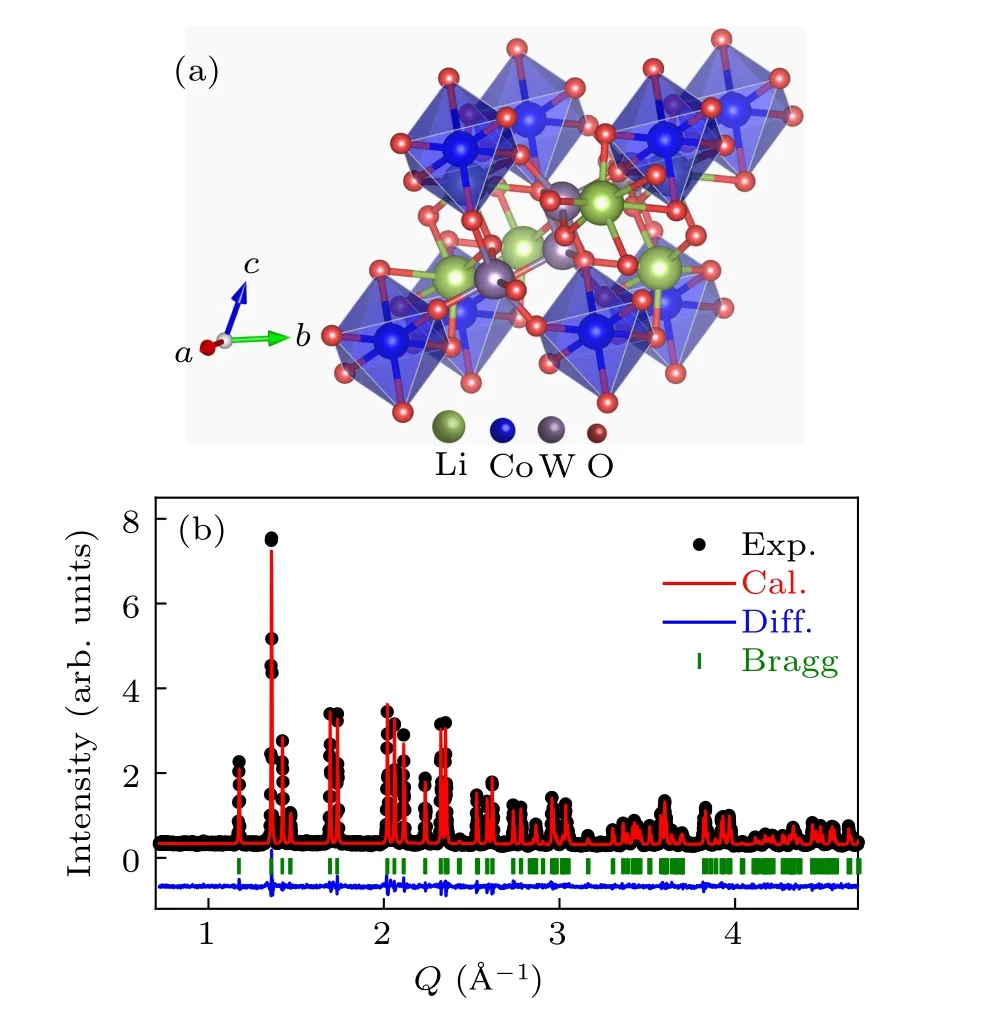
Fig.1. (a)The crystal structure of Li2Co(WO4)2. (b)The measured(black)XRD patterns and the refinement(red)of Li2Co(WO4)2 measured at 300 K.The olive bars denote the Bragg positions and the blue curve shows the difference.
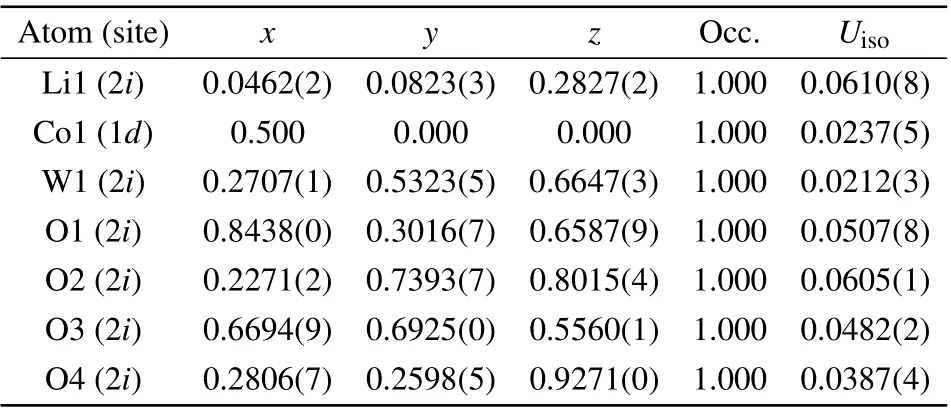
Table 1. Refined structural information of Li2Co(WO4)2 from powder x-ray diffraction.
The temperature dependent magnetic susceptibilityχ(T)of Li2Co(WO4)2measured underH= 1 T is shown in Fig. 2(a). The Curie-Weiss temperatureθCW~-37.16 K was acquired by fitting the 1/χ(T) curve above 150 K using the Curie-Weiss lawχ=C/(T-θCW). The negativeθCWdenotes that AFM interactions dominate between Co2+spins. The effective magnetic moment is calculated to beµeff= (8C)1/2= 5.48µB. This value is larger than expected one 3.87µB(S=3/2)for high-spin Co2+,which suggests the existence of the orbital contribution. This value is similar to previous reports for high-spinS= 3/2 Co2+,e.g., Co3Al2Si3O12,[42]Co4Nb2O9,[43]Na2BaCo(PO4)2,[21]and BaCo2(AsO4)2.[22]This high-spin state can persist to low temperatures (e.g., down to 15 K), according to the Curie-Weiss fitting as shown in the insert of Fig.2(a). Interestingly,theS= 1/2 low-spin state existing in many cobalt oxides(e.g., Ba3CoNb2O9[15]and Na2BaCo(PO4)2[21]) at low temperatures is not observed here,which will be further confirmed by the neutron study and DFT calculation.

Fig. 2. (a) The temperature dependence of magnetic susceptibility χ(T)(left y-axis) and its inverse (right y-axis) of Li2Co(WO4)2 under H =1 T.Insert: the low temperature range fitting. (b)Magnetic susceptibility χ(T)under various magnetic fields. The inset displays dχ/dT around the phase transition temperature range.
Figure 2(b) shows theχ(T) of Li2Co(WO4)2measured under various magnetic fields. A broad peak aroundT~11 K is observed originating from the short-range magnetic ordering in low-dimensional magnets. No remarkable anomalies were observed below 10 K.Using the derivative(dχ/dT),two successive peaks atTN1~9 K andTN2~7 K are clearly seen,as shown in the inset of Fig. 2(b). The broad peak shifts to lower temperature with increasingH,consistent with previous studies.[26]
TheH-dependent isothermal magnetizationM(H)at different temperatures is shown in Fig. 3. TheM(H) shows nonlinear behavior under external fields belowTN2, suggesting possible field-induced transitions such as spin-flop effects.[26,44]AboveTN1,M(H) shows linear behavior and does not saturate up to 9 T.
Specific heat(Cp)of Li2Co(WO4)2was measured a under different external fields. As shown in Fig.4(a),two distinctλshaped peaks atTN1~9.4 K andTN2~7.4 K are observed under zero field,which further confirms the two successive AFM transitions. Figure 4(b) shows theCpof Li2Co(WO4)2under the selected fields.Both peaks inCpshift to lower temperature and become broader,symbolize the AFM nature. This feature was also observed in other Co-based low-dimensional magnetsACo2V2O8(A=Sr and Ba)and Ba3CoNb2O9.[16,17,45]
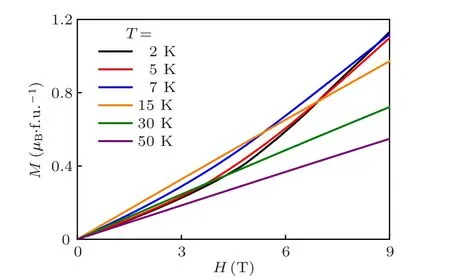
Fig.3. The isothermal magnetization M(H)versus magnetic field at various temperatures.Below TN2,the M(H)curves have slope changes at ~5 T,due to possible spin-flop effects.
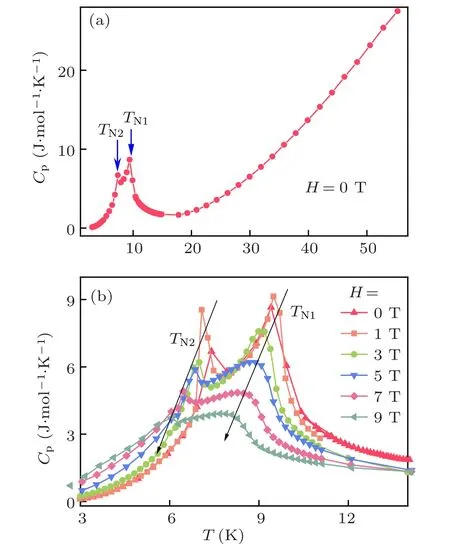
Fig.4. (a)The specific heat Cp of Li2Co(WO4)2 under zero magnetic field.(b)Cp of Li2Co(WO4)2 under different applied magnetic fields.
To investigate the magnetic ordering of Co2+ions in Li2Co(WO4)2, NPD patterns have been collected both above(T~30 K) and below (1.7 K) magnetic transition temperatures. The experimental data (black dots) and the Rietveld refinements profiles (red curves) are shown in Figs. 5(a) and 5(b). The Bragg positions are marked using the vertical bars while the difference between the experimental and refined data is plotted in the insert panel. The nuclear refinement using the 30 K data shows that the lattice parameters area=4.90451(9) °A,b=5.65117(14) °A,c=5.86421(12) °A,α=69.5307(10)°,β=91.3690(12)°andγ=116.1986(16)°,which are in good agreement with our XRD results and previous data.[41]

Fig. 5. The experimental NPD data collected at T =30 K (a) and 1.7 K (b) and the refinement results, respectively. The inset displays the enlarged area of the low-Q region where additional magnetic peaks appear. (c)The temperature evolution of the magnetic scattering measured at low Q. (d)The refined magnetic structure of Li2Co(WO4)2 at 1.7 K.
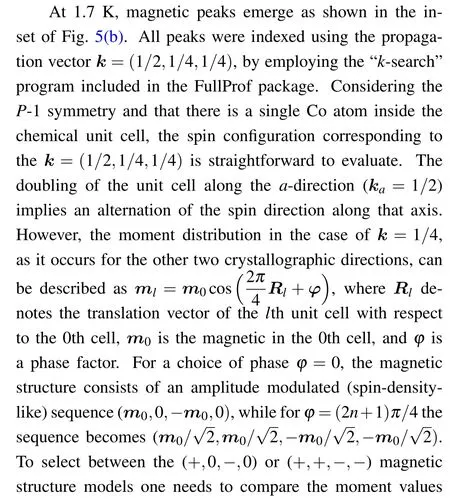


The temperature evolution of the magnetic peaks was obtained by collecting diffraction patterns using small temperature steps between 2 K and 9 K. The corresponding contour map is displayed in Fig. 5(c). A clear feature is that belowTN2~7 K,the magnet Bragg peak positions do not shift as a function of temperature, and the associated propagation vectorkis commensurate. In comparison,betweenTN1andTN2,the position of the (1/2,1/4,1/4) magnetic Bragg peaks located near 0.9 °A-1displays a strong temperature dependence while the intensity becomes weaker and disappears aboveTN1.This is similar to that in Li2NiW2O8, three magnetic Bragg peaks appear betweenTN1andTN2,corresponding to an incommensurate SDW-type ordering.[27]It is thus plausible that a similar incommensurate-commensurate magnetic transition also occurs in our Co-based system. The shift in peak position corresponds to a gradual change from the commensuratekC=(1/2,1/4,1/4)to an incommensuratekIC=(1/2,ζ,ξ)wave-vector indicative of an SDW-type ordering.
To further verify the experimental observed magnetic configurations, here a DFT calculation is performed. Three possible magnetic orders are considered, including the ferromagnetic (FM), G-type antiferromagnetic (GAFM), as well as the one found by neutron study (N-AFM) with a propagation vectork=(1/2,1/4,1/4). Using the standard GGA+U(Ueff=4 eV) calculation, the energy of N-AFM is the lowest among these three configurations, in agreement with the result of NPD. In addition, the local magnetic moments of Co2+are found to be 2.74µB,also very close to the aforementioned one obtained by NPD.Such a large magnetic moment is about three times of the expected value ofS=1/2 state(e.g.,0.97(1)µB/Co2+in Ba3CoNb2O9),[15]further supporting the 3d7high spin configuration. The energy difference between N-AFM and G-AFM is only 0.4 meV/Co. Such a tiny difference implies the lowTN, in consistent with the experimental one. Also, the optimized lattice constants (a=4.924(2) °A,b= 5.620(2) °A,c= 5.879(1) °A) are very close to the experimental ones (a=4.9247(03) °A,b=5.6707(38) °A,c=5.8858(63) °A).
Then, the electronic structure of Li2Co(WO4)2at the magnetic ground state is calculated, as shown in Fig. 6.Li2Co(WO4)2is an antiferromagnetic insulator with a DFT band gap ofEg~2.6 eV,which substantially agrees with the band gap about 3.1 eV measured by light absorption.[46]The atomic projected densities of states are also shown in Fig.6(a).The topmost valence bands are mostly contributed by Co and O,while the lowest conducting bands are mostly from W.The spin-polarized density of states shown in Fig. 6(b) suggests that the magnetic moments are from Co2+ions,as expected.

Fig.6. The density of states of Li2Co(WO4)2 in the magnetic ground state.(a)The total and atomic projected density of states. (b)Spin-polarized density of states of one spin-up Co ion.
4. Conclusion
In summary,the magnetic susceptibility,specific heat and neutron diffraction measurements reveal that Li2Co(WO4)2undergoes two successive magnetic transitions. It firstly enters the SDW state atTN1~9.4 K, and orders belowTN2~7.4 K with a commensurate AFM structure characterized by the propagation vectork=(1/2,1/4,1/4). The refined Co2+magnetic moment is 2.8(1)µBat 1.7 K. DFT calculation is consistent with the refined magnetic structure and Co2+magnetic moment.
Note added Meanwhile, we note that Karnaet al.conducted a similar neutron diffraction study on Li2Co(WO4)2,which gave rise to the same conclusion.[47]
Acknowledgments
Project supported by the National Natural Science Foundation of China (Grant Nos. 11834002, 12074111, and 11704109)and the National Key R&D Project of China(Grant No.2016YFA0300101).
The research at Oak Ridge National Laboratory’s High Flux Isotope Reactor was sponsored by the Scientific User Facilities Division,Office of Basic Energy Sciences,US Department of Energy.Most calculations were supported by National Supercomputer Center in Guangzhou(Tianhe II).
- Chinese Physics B的其它文章
- Quantum walk search algorithm for multi-objective searching with iteration auto-controlling on hypercube
- Protecting geometric quantum discord via partially collapsing measurements of two qubits in multiple bosonic reservoirs
- Manipulating vortices in F =2 Bose-Einstein condensates through magnetic field and spin-orbit coupling
- Beating standard quantum limit via two-axis magnetic susceptibility measurement
- Neural-mechanism-driven image block encryption algorithm incorporating a hyperchaotic system and cloud model
- Anti-function solution of uniaxial anisotropic Stoner-Wohlfarth model

